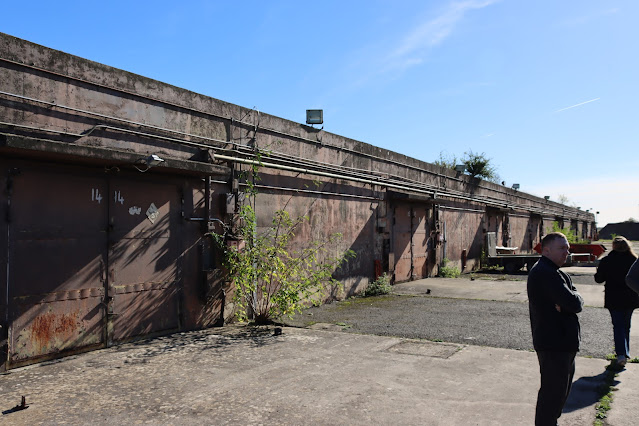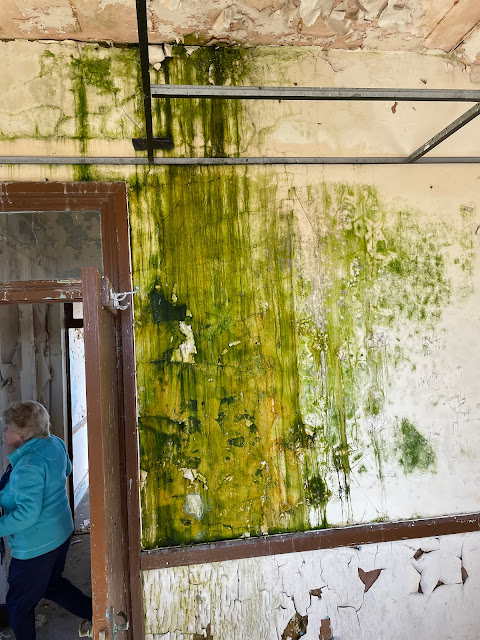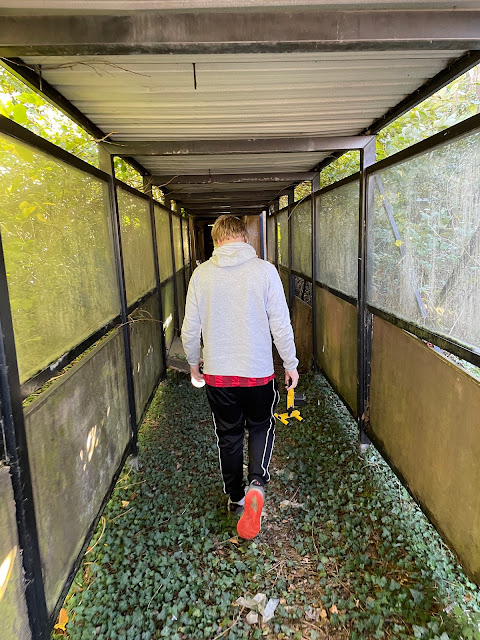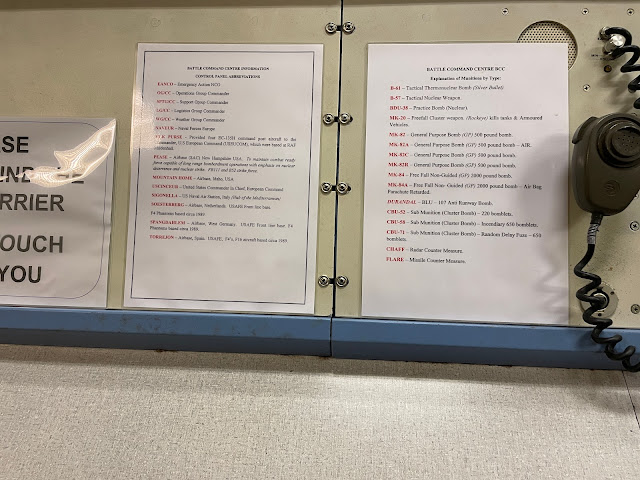For our last day, we were lucky enough to organise a visit to Upper Heyford airbase. Kristine and I had visited before (Upper Heyford Tour, April 2016) but this was the first time we had been able to take the boys. Because I was pretty comprehensive in the history, maps and base layout in the previous post, I will focus more on the different things we saw and new facts we learnt this trip.
My grandfather had served in Upper Heyford in 1954 as part of the 98th Chemical Company. The Airbase was originally owned by the English Airforce, but after the war it was taken over by the US who used it as a base during the Cold War (starting 1952). In 1991/92 the Americans left the airbase and it has been abandoned since then. Large portions of the support areas have been replaced with housing, but many of the old buildings remain and in some cases have been hired out for storage.
The tour started at 9:30 and was due to finish around 12:30, which was perfect timing as we were due to fly out of Gatwick Airport (1.5hrs away) at 5:30 that night. The tour ended up finishing at 3pm which made it quite a rush to get back to the airport in time, but it was great to see some of the same buildings we saw before and also some new areas.
Our first stop was the new visitor and tour centre, which had been an abandoned dormatory last time we visited.
The first stop was the Avionics Maintenance Building, which was originally used to remove the sensor pods from the aircraft, they would then be lifted by crane into the secure building and interrogated. These areas were secure and only accessed by certified staff. There were decontamination showers outside and multiple guard posts. We weren't allowed inside this time as the rooms had been prone to flooding and since they were 'clean rooms' they had slick tiles. On a previous tour someone had slipped over and so it was no longer safe to take the tours inside.
The trenches outside the building were used for filming the bicycle chase scene in "World War Z":
Next, we headed to the QRA (Quick Response Area).
As I said in the previous post:
The QRA was the rapid response section of the airbase. It was established to provide a 3 minute launch time for aircraft in retaliation to an attack from the Soviets. Pilots and flight crew lived in the QRA 24 hours a day, 7 days a week, while security performed eight hour shifts.
The QRA was surrounded with two rows of wire fence. The security team were authorised to give a warning if anyone approached or touched the first fence, but to respond with deadly force if anyone touched the second fence.
One new fact that we learnt was that if any movement was detected by the fence sensors the base (and all attached airbases in the UK) would immediately be triggered to Yellow alert. There were also plastic tubes filled with an alcohol that would detect movement on the grass between the fence and trigger the alarm.
The back of the hanger had large metal doors that could be opened into this vented section. That way when the jet engines were fired the flames and exhaust would be defused and vented out of the angled section. Some newer hangers had 'ear-shaped' sections that were more efficient at dissipating the exhaust.
Our first stop was the gate house. It consisted of a section between the two fences. A vehicle would arrive and enter through the first gate. The passengers would then exit while security inspected the vehicle. The personnel would be processed at the guard house and issued with their passes. They could then pass the turnstile and renter their vehicle. The second gate would then be opened allowing them into the QRA.
 |
| No Man's Land between the fences |
 |
| A nest and eggs in the sink |
 |
| Racks for the security badges |
Our next stop was one of the hangars. When we were last here, we visited hangar 7, this time it was hangar 9. Each hangar was named after members of the US Airforce. Hangar 9 was named after 1st Lt Robert W Ahern, who was MIA in 1944 during an air raid to France.
The massive doors were opened easily by motors on each side of the hangar:
The artwork inside this hanger was different to Hangar 7:
Next stop was the T2 Jet Engine Cell. This was where all jet engines would undergo maintenance and lifecycle testing. The biggest problem with this design was the any unburned jet fuel in the exhausts would be vented out and settle on the main runway. Eventually this was replaced with a more modern design.
From my earlier post:
The T2 facility used a water-cooled emissions diffuser to deal with the jet afterburn while the jets were being tested. Thousands of gallons of high pressure water was pumped from a pump room into the diffuser where it absorbed the heat of the jet engine. The super heated water would escape the facility as steam and rise hundreds of feet above the facility. This could cause problems in winter as the steam would then settle as ice throughout the base.
In 1988 a jet engine failed and caused significant damage to the cell, so a newer and safer cell was created, the T9 Engine Test Cell, which utilized a augmentor acoustic tunnel rather than the water-cooled diffuser.
We also passed one of the shelter blocks on the way. There were several of these around the base in case of a nuclear/biological/chemical attack. staff could decontaminate and change to protective suits here. Each had limited space and the next nearest block could often be kilometres away. The main control room was able to track the number of occupants of each block and hence advise staff on where to go:
 |
| Shelter Block |
 |
| Water Cooler for Exhaust |
 |
| Sprinkler system to flood the room if the engine caught fire |
 |
| Mountings for the engine |
We then took a drive out to the secure weapons storage area, viewing a few buildings along the way:
 |
| Hush House - A sound proofed room for testing aircraft engines |
 |
| 42nd Electronic Combat Squadron (see the previous post for the funny story explaining the metal plate on the wall and the yellow paint) |
 |
| 77th Tactical Fighter Squadron |
Last visit we hadn't been able to enter the Secure Weapons Storage area as it was locked up, but this time we got to go inside and view the weapons storage area. While Upper Heyford never officially held nuclear weapons there were separate areas for storing the bombs and the detonator units.
The buildings were disguised as regular office buildings, or buried under earth to appear as hills from the air.
 |
| The safe door to the detonator storage area |
 |
| Painting across from the detonator storage area |
 |
| Door to the battery room |
 |
| Heading into detonator room |
 |
| The inner door with two door locks - requiring two authorised personnel to enter |
 |
| Thickness of the outer door |
On the way out of this area we moved around past the main guard tower. Tomas climbed to the first turn in the stairwell before the loose handrail made him turn around. Kristine was brave (stupid) and made it to the top to take some great pictures. I didn't even step on a single step.
 |
| Tower |
 |
| Proof that she made it to the top (in case we needed it for the medical claim...) |
Kristine's explorer attitude must have impressed one of the guides as he let us into one of the other rooms - this one heavy with bird poo and peeling paint to view another of the artworks:
We met back up with the group outside the bomb storage bunkers. The left most bunker had a strange join line in the concrete - it turns out that 14 bunkers were planned, but 13 were installed. The base commander than ordered the extra one to be added onto the end.
 |
| Small arms storage |
 |
| Hangar with the 'ears' configurator for the exhaust |
 |
| Whiskey 13 - see my previous post for the story. |
Next stop was the control tower. Last time we saw the outside, but this time we were able to go inside.
 |
| Red Kite flying overhead |
 |
| The firefighting training tower |
 |
| Magnetometer - see previous post for more details |
We had a quick stop in another hangar to see more artwork:
Our second-to-last stop was a new building they had just opened up, housing the officers mess and communications:
 |
| The bar |
Our final stop was the Command Post. I have a lot more photos and details in my previous post. One big different was that the safe door to the map room was now locked and unable to be opened. On a previous tour, the granddaughter of one of the guides had pulled it shut behind her and now they were unable to open it without damaging it (not allowed in a heritage listed site). My previous post had some pictures of the maps on the walls of the room.
Here's some of the pics we took on this visit:
 |
| Number of people in each of the shelters as I mentioned earlier |
 |
| Base Status |
The above boards show the status:
Air Raid Warning:
White - All Clear
Yellow - Preliminary Caution
Red - Raid Imminent, sound sirens
Local Alarm Condition:
Yellow - Attack is probable in less than 30min
Red - Attack is imminent or in progress
Black -Attack is over and contamination (Nuclear, biological, chemical) is suspected to be present
Alert Status:
State Orange - Counter-surprise conditions - expected enemy attack within hours
/State Scarlet - Counter-surprise conditions - expected enemy attack within an hour
MIL VIG - Military Vigilance - lowest alert stage, for low level by increasing international tension
SIMPLE - NATO assigned forces at maximum readiness
FGL - Force Generation Level
Because the tour finished late, we had a crazy rush to get to the flight on time, but we made it and arrived back in Copenhagen late that night.































































































No comments:
Post a Comment